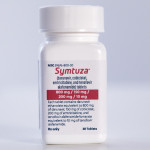Additional results from two ongoing clinical trials of Prezista™(darunavir), Tibotec, Inc.’s protease inhibitor approved by the U.S.Food and Drug Administration (FDA) in June, suggest that the drugoffers prolonged treatment effects for HIV-positive people with limitedtreatment options. The new data, reflecting 48 weeks of follow up fromthe clinical trials, were reported today at the XVI International AIDSConference (IAC) in Toronto.
Prezista was approved bythe FDA based largely on early results from two phase IIb clinicaltrials called POWER 1 and POWER 2. The two studies enrolled 588HIV-positive people who had previously been treated with at least one protease inhibitor, one non-nucleoside reverse transcriptase inhibitor(NNRTI), and one nucleoside reverse transcriptase inhibitor (NRTI). Patients also needed have evidence, by way of drug-resistance testing, of one or more HIV mutation known to contribute to resistance to older protease inhibitor options.
The study participants were randomized to one of two groups. In the first group, 131 patients are taking Norvir®(ritonavir)-boosted Prezista (600mg plus 100mg Norvir) twice daily plusan optimized background regimen (OBR). In the second group – thecontrol group – 124 patients are taking an approved Norvir-boostedprotease inhibitor plus OBR.
Twenty-four week data from both studies combined, which were reviewed by the FDA and used to support accelerated approval of the drug, demonstrated that patients in POWERs’ Prezista groups were more likely to achieve undetectable viral loads and experience increases in CD4 cell counts compared to control patients in the study.
After24 weeks of follow up, 45% of patients in the Prezista groups had viral loads below 50, compared to 12.1% of patients in the control groups.
The combined 48-week data from the studies were reported at IAC by Sharon Walmsley, MD, a POWER researcher and Senior Scientist at the Toronto General Research Institute. She reported data involving 110 patients who had reached 48 weeks of treatment in the Prezista groups and 120patients who reached 48 weeks of treatment in the control groups.
According to Dr. Walmsley, 61% of patients taking a Prezista-based regimen had viral loads that were at least 1 log below their pre-study levels. In the control groups, only 15% had a similar viral load response after 48weeks of treatment. As for undetectable viral loads, 46% of the Prezista-treated patients had viral loads below 50 after 48 weeks,compared to 10% of the control patients.
EncouragingCD4 count data were reported as well. After almost a year of treatment,Prezista-treated patients experienced, on average, a 102-cell increase,compared to an approximate 19-cell increase in the control groups.
Thus far, the most common side effects in the Prezista-treated patients, compared to those in the control group, include diarrhea (20% in the Prezista group vs. 28% in the control group), nausea (18% vs. 13%), headache (15% vs. 20%), and fatigue (12% vs. 17%). Dr. Walmsley noted that while increases in cholesterol and triglycerideshave been noted in patients participating in the studies, theseincreases do not appear to be any more common in the Prezista-treated patients compared to those in the control groups.
The POWER researchers plan to publish final data from POWER 1 and POWER 2based on 96-week follow-up results. However, Dr. Walmsley and her group will follow patients for a total of 144 weeks—approximately three years of effectiveness and safety data.
Advertisement
Advertisement
Advertisement






Comments
Comments